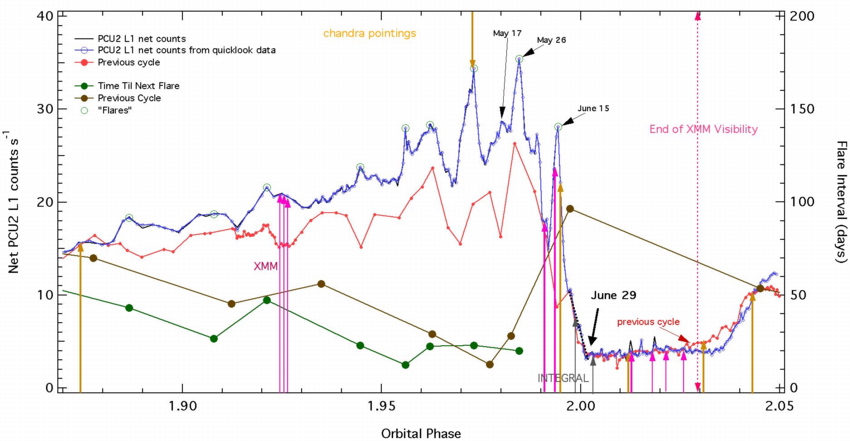
November 21 Update: the recovery continues - it's interesting that today's rate is about the same as the rate at this phase in the last cycle.
September 23 Update: The rate has climbed above 10 cts/s for the first time since June 22. Apparently the eclipse is over! Amy Fredericks guessed the date that we observed the recovery, but Tony Moffat guessed the date at which the recovery level was reached (interpolating between the 2 bounding RXTE observations). Kudos!
September 15 Update:The totality apparently ended on Sep 9, at a PCU2 L1 rate of 4.7 cts/s. There's been a steady increase up through today. Presumably this increase will continue...
June 30-July 17 Update: The minimum indeed began on June 29. The new X-ray period is P=5.536 years. The current minimum level is the same as the minimum level in the previous cycle, despite the fact that prior to the minimum the X-ray flux was about 23% brighter than last cycle. How long will it last?
June 29 Update: Reached 3.1 cts/s in PCU2 L1, about the level of (though slightly lower than) the last minimum. Apparently the minimum has begun
(or will the X-ray rate continue to drop?)June 28 Update: June 29 looking good.
June 27 Update: June 29-30?
June 26 Update: Slight increase - Minimum near June 29?
June 25 Update: fit to the observations since June 21 suggests a minimum near June 28
June 23 Update: Drop by 1.8 cts/s - Minimum near June 24?
June 22 Update: Looking at the last minimum, the level 3.5 PCU2 L1 cts/s with a scatter of about 0.3 cts/s. In light of Augusto's recent e-mail about the start of the spectroscopic minimum, perhaps the X-ray minimum has begun, but at an elevated level (10 cts/s vs. 3.5) compared to last time? If so, what does this say about the binary model? It seems like a large change in the minimum X-ray brightness from cycle to cycle would be difficult to explain by an X-ray eclipse! Again judging from the last minimum, I expect that the eclipse will be characterized by a relatively constant brightness level with a scatter of no more than 0.4 cts/s for 1 week or so. We're not there (quite) yet!
June 18 Update: Since the (surprising) peak on June 15, the X-ray count rate has declined steadily. A straight line fit suggests that the X-ray minimum will be reached on June 20.
June 7 Update:The rate of decline has accelerated: Today's decline is about 6 pcu2 layer 1 counts/s/day, the largest one-day decline ever observed for Eta Car by RXTE. A straight line fit to the data since the last peak on June 4 suggests the X-ray minimum will start on June 11 if the decline is linear.
June 5 Update: The rate of decline has slowed (in fact today's observation shows a brightening of the source). A straight line fit is consistent with a June 27 start for the minimum.
May 30 Update: There's been a steady decline since May 26, which, if fit by a straight line, suggests that the minimum will occur near June 7, 2003!
May 16 Update: The brightening continues, though at a slower rate than expected. Fitting (by eye) a straight line to the brightening since the minimum on May 8, and a line to 3/4 of the last peaks implies that the next peak will occur on May 31. Presumably this will be the final peak (at a predicted PCU2 L1 rate of about 38-39 cts/s) and if the decline to minimum occurs at the same rate as in 1997, then the X-ray minimum would occur near July 24.
Here's the situation as of May 6 2003: The last few X-ray peaks are separated by about 22-23 days. The most recent peak occurred on May 3, so the next peak (should it occur) would occur on May 25-26. Extrapolating from the trends in the amplitudes of the last few peaks, the amplitude of the next peak should be about 37 cts/s in PCU2. Presumably this would be the last peak prior to the decline to minimum. If the decline to minimum occurs at the same rate as last time, then the X-ray minimum should occur on July 11, 2003
Alternatively, if the May 3 peak is the last one prior to the decline to minimum, then the decline of the X-ray rate is much steeper than last cycle, and minimum should occur at phi=0.985=May 25, 2003.
So we should be at either a maximum or a minimum near May 25
Derby Voting:
Date of minimum Name ---------- ---- June 11 Ian June 20 Julian June 21 Susan June 22/23 Thom June 25 Augusto, Thom June 26 Gladys June 27 Mike, Virpi June 28 Ted June 29/30 Gloria June 30 Roberto, Alexander July 2 Andy, Kenji July 4 Henrik, Amy, Ted July 5 John H. July 10 Ian July 15 Jean, Thom
Please send any additions or corrections to Mike Corcoran.